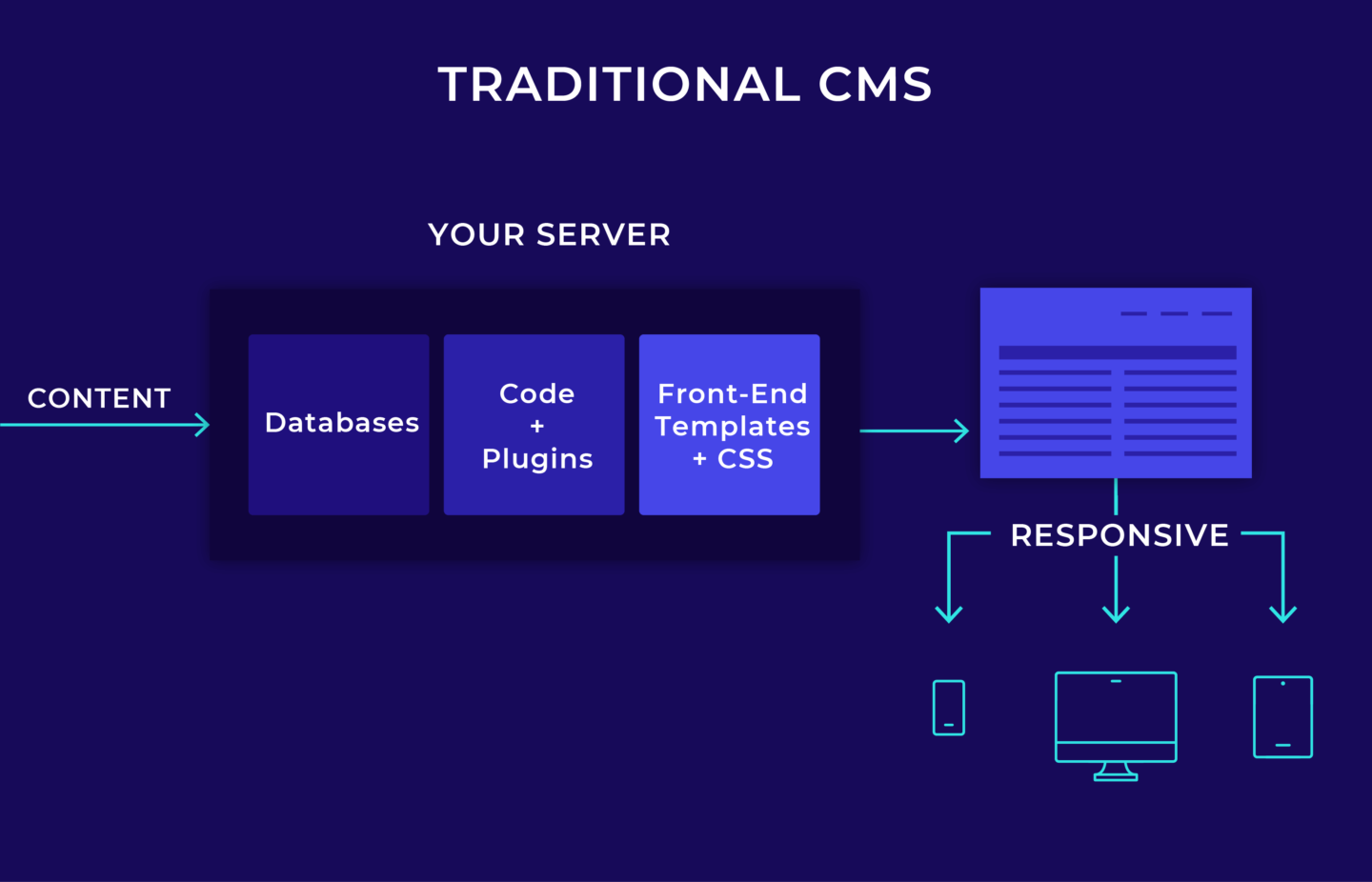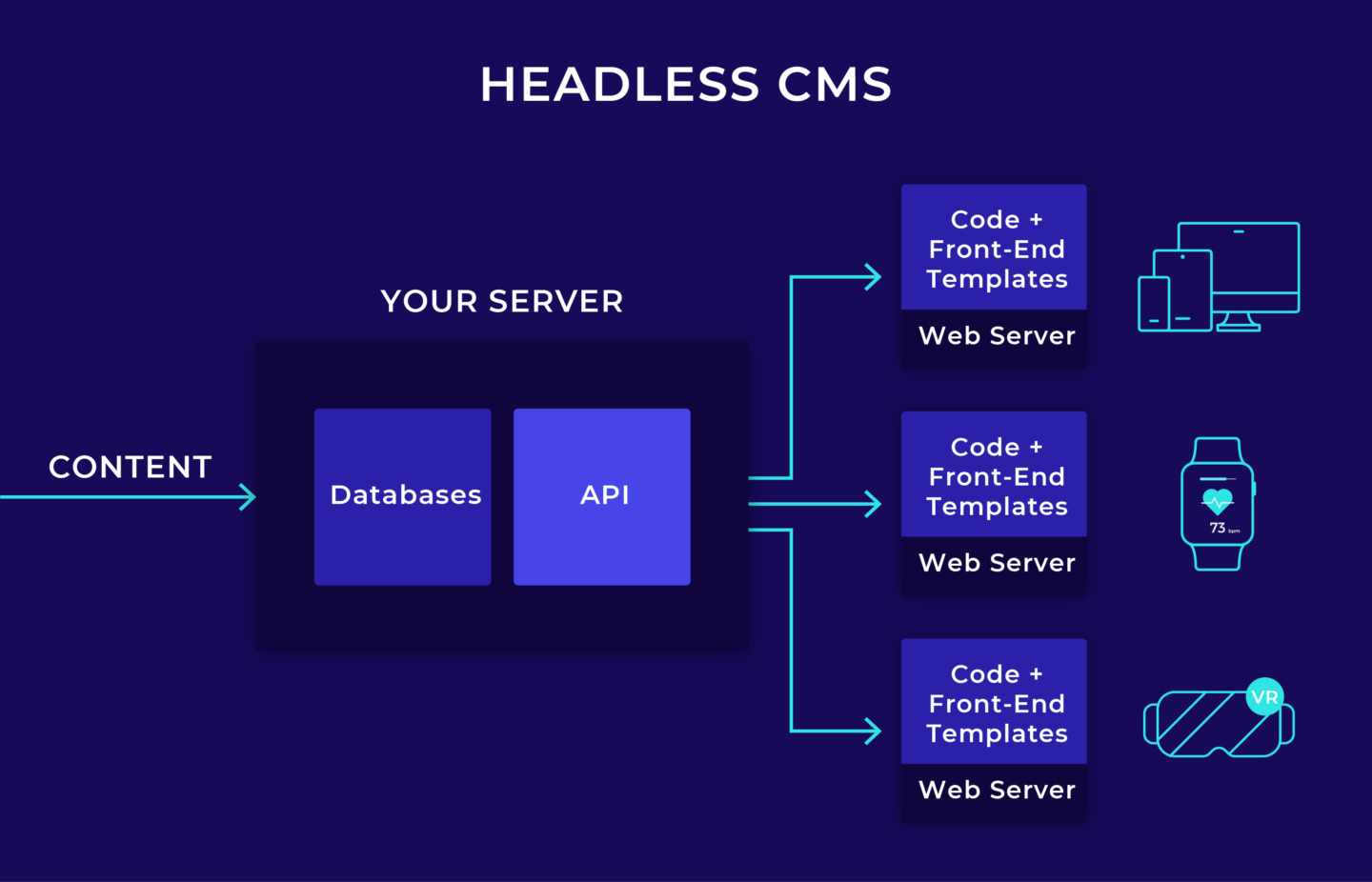
Have you ever wondered what Headless CMS’s are and why they were developed? In this article, we’ll be taking a look at the concept of Headless CMS’s, explaining how they work and examining whether or not they might be suitable for your business.
Let’s get going!
The Problem With A Traditional CMS
Most Content Management Systems (or CMS’s) like WordPress operate with a single environment that bundles together everything needed to handle both the back end (your WP Admin area) and front end layers of your website.
This is a great solution and one that has worked incredibly successfully for many years now. It’s convenient and makes managing a website super easy which is why CMS’s are now so popular.

There are however some drawbacks to the architecture of a CMS like WordPress particularly when you need to display your back-end content on multiple channels, such as social media platforms, other websites, or an app. And that’s because of the strict dependency between the front-end and back-end layers of a traditional CMS.
Headless CMS‘s
In contrast to ‘normal’ CMS’s that we’re all used to using, a Headless CMS is ‘a back-end-only content management system that acts primarily as a content repository. A headless CMS makes content accessible via an API for display on any device without a built-in front-end or presentation layer.‘
NOTE: An Application Programming Interface(API) is a way to interact with our application programmatically. It’s an intermediate layer whose role is to allow communication between two applications.
So, in summary, the main difference between a traditional CMS and a Headless CMS lies in how the content generated by the back end is delivered.
When discussing Headless CMS’s you’ll see lots of references to the “head”, which in this context is where the content generated by your CMS is displayed (such as an app). The “body” in the context of a Headless CMS refers to where you store and manipulate your data.
NOTE: The “head” and “body” terms are conceptual and have nothing to do with the well-known head and body of the HTML language.
So, in summary, a Headless CMS enables you to separate data manipulation and presentation, giving you the flexibility to deliver a truly omnichannel experience for your customers which is delivered from a single back end which makes life a lot easier. For example, if you are pushing content to a social media channel, a website and an app and you want to make some changes, that’s normally three back ends that would need to be updated. With a Headless CMS, you’re down to one.

Sounds great right. There is a disadvantage of using a headless CMS though… cost.
The increased cost of using a Headless CMS is in part due to the fact that its implementation and maintenance is a lot more complicated. As such, it’s likely that the initial setup would need to be undertaken by an experienced developer, unlike a traditional CMS which is user-friendly enough to be setup and operated by someone of more limited technical experience.
Costs can also be greater because the separation of layers (back end and front end) might require more than one hosting service in order to operate.
Benefits of Headless CMS‘s
So, when a Headless CMS costs more to setup and is likely to be more complicated to run, why would you choose to opt for one? Let’s look at some of the benefits:
Development Flexibility
Headless CMS’s serve their content via API’s. This means that developers have the freedom to choose the front-end tools and technologies that are optimal for their clients. Making changes to these at a later date is also a lot easier.
Speed
The speed of websites can be enhanced with Headless CMS’s as the website only has to handle the code for the front-end element of your website. This is because with every page load request, only the necessary files are called through API and the core files and functions are postponed and thus do not take additional time (which shows up in the form of a slower page load).
Try our Award-Winning WordPress Hosting today!

From a development perspective, things are also quicker as teams can work in parallel (for example one team on the back end CMS and another on the front end website).
Security
The separation of back and front layers leads to a securer environment. The back-end CMS can be completely locked down. Additionally, as front-end content is delivered via intermediate API’s, this means malicious actors can’t reach your database in the way they can with traditional CMS setups.
Scalability
For many businesses, it’s enough to create a responsive website that works on desktops and mobiles. Things however have got increasingly complex with the advent of things like wearables, whilst the proliferation of additional marketing channels (such as billboards, social channels, mobile apps etc.) continues to climb. Serving correctly formatted content to all of these via a traditional CMS would be close to impossible as content would need to be reformatted to suit each of these channels.
With Headless CMS’s, content is served from a single source whilst the front-end is treated independently. This makes handling omnichannel content a whole lot easier and much more practical.
Future-proof
Because of the way Headless CMS’s are structured, it is a lot easier to adapt to new technologies and marketing channels as they emerge over time. Whilst the initial setup of a Headless CMS is more onerous, they do allow you to react much more quickly to ever-changing digital landscapes. This is important, especially if you are operating in a competitive sector.
Headless WordPress
So, can WordPress be operated as a Headless CMS? Yes. WordPress made Headless possible in 2016 by creating the REST API. It is the interface WordPress provides that allows you to securely send and receive content as raw data (JSON format) between applications and your WordPress site.
Learning how to use REST API is out of scope in this article, but if you want to read more about this, you can visit our introductory article to WordPress REST API.
A Headless WordPress site has all the Headless CMS characteristics described above, combined with the advantage of using a familiar back-end. This can be really beneficial especially if you and your team are currently used to using WordPress.
Should I Go Headless?
If you have a small website with content that doesn’t need to be served to any other channels (such as an app) then it’s unlikely using a Headless CMS would offer any advantages. On the contrary, your costs will go up as will the complexity of managing your site.
Headless CMS’s really come into their own however when you need to push content to multiple channels simultaneously (sometimes referred to as Omnichannel Digital Marketing). If this sounds like your business then the Headless approach is definitely worth considering!
Start Your 14 Day Free Trial
Try our award winning WordPress Hosting!



















